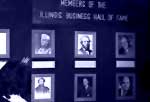Early in its history the Illinois Business Hall of Fame established a museum program for the purpose of making public portions of the educational program. Also created was an archives program to accumulate materials available for future research into the lives of the laureates.
The museum program began as a collection of exhibits and handout materials in a large room in Stipes Hall at Western Illinois University. A few travelling exhibits were undertaken at public libraries in Aurora, Elk Grove Village and Springfield. The exhibit at Elk Grove Village featured the career of United Airlines’ legendary CEO “Pat” Patterson. Patterson, himself, showed up to kick off the exhibit. The museum program evolved into a hallway displays program in Stipes Hall. The hallway halls in the first three floors of that building were covered with simple, easy—to-read, exhibits featuring highlights of laureate biographies. In addition a huge display of laureate photos was created on the first floor. Over the course of several years it became apparent that hallway exhibits were an excellent way of creating student awareness. Consequently plans were made to expand the exhibit concept to other participating universities with more elaborate exhibit formats. The first such expansion took place at Illinois State University’s new business college building.With the emergence of the World Wide Web the IBHF directors decided to move the museum program to the web. Plans were in place to eventually create a virtual museum format at the time the IBHF board decided to contract with the Western Illinois University Libraries to maintain the web site. Under the terms of the contract, the WIU Libraries are permitted but not obligated to move forward with such a plan and the funding provided by the contract was not sufficient to make that likely.The archives program was initially entrusted to the Center for Business and Economic Research at Western Illinois University. That entity collected print biographies, company histories, and other materials and place them in safe-keeping. When the Center was abolished for budgetary reasons in the early 1990s, the materials were reassigned to the Archives Department at Western Illinois University.
The museum program evolved into a hallway displays program in Stipes Hall. The hallway halls in the first three floors of that building were covered with simple, easy—to-read, exhibits featuring highlights of laureate biographies. In addition a huge display of laureate photos was created on the first floor. Over the course of several years it became apparent that hallway exhibits were an excellent way of creating student awareness. Consequently plans were made to expand the exhibit concept to other participating universities with more elaborate exhibit formats. The first such expansion took place at Illinois State University’s new business college building.With the emergence of the World Wide Web the IBHF directors decided to move the museum program to the web. Plans were in place to eventually create a virtual museum format at the time the IBHF board decided to contract with the Western Illinois University Libraries to maintain the web site. Under the terms of the contract, the WIU Libraries are permitted but not obligated to move forward with such a plan and the funding provided by the contract was not sufficient to make that likely.The archives program was initially entrusted to the Center for Business and Economic Research at Western Illinois University. That entity collected print biographies, company histories, and other materials and place them in safe-keeping. When the Center was abolished for budgetary reasons in the early 1990s, the materials were reassigned to the Archives Department at Western Illinois University.





